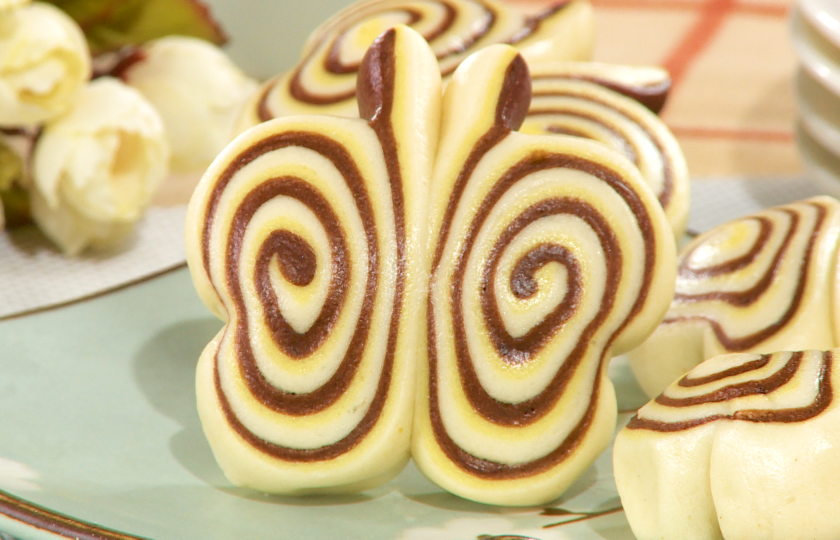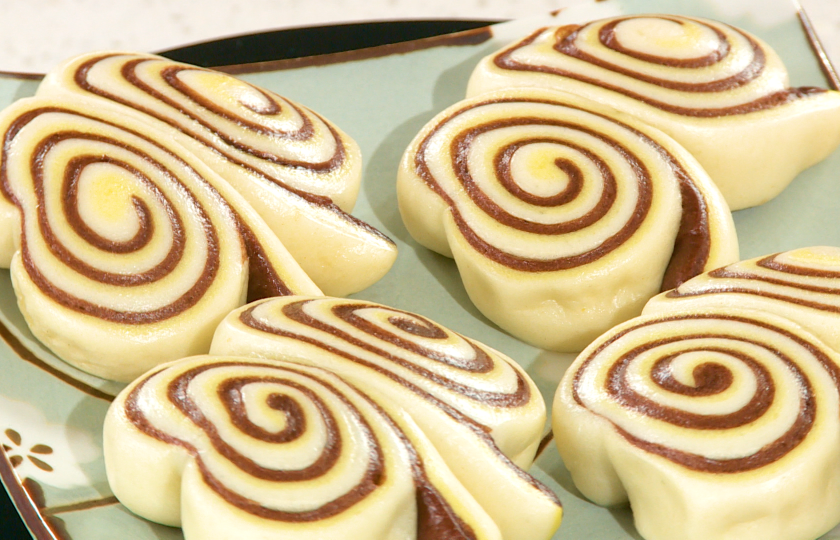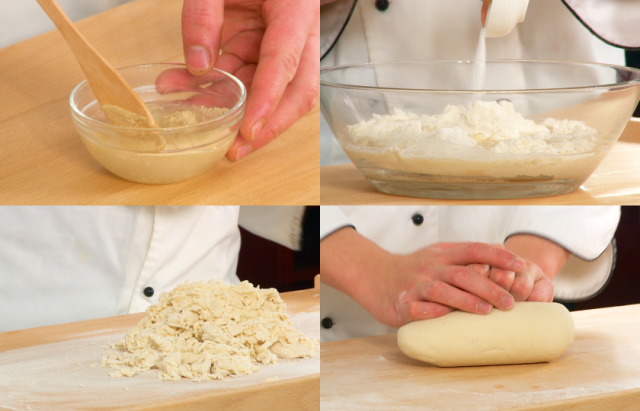Gourmet Chinese Butterfly Rolls Recipe


If you are a novice friend who has just started to get in touch with pasta making, then butterfly rolls are definitely an excellent entry-level choice for you! Its method is simple and easy to understand, and it is easy to get started, so that you can quickly experience the sense of accomplishment of making pasta by yourself. Come and try this recipe.
What are butterfly rolls
Butterfly rolls are a traditional Chinese pasta. Just looking at the appearance, it gets its name because it looks like a butterfly. Through ingenious production techniques, by rolling and squeezing the dough, it turns into a lifelike butterfly shape. With this unique shape, it stands out immediately among many pastas. It can not only be used as a daily staple food, but also be used to decorate the dining table on special occasions.
Talking about the taste, butterfly rolls are very soft and delicious. Yeast powder and baking powder are added during production, so the dough can fully ferment. After steaming, it has a porous structure. The addition of white sugar adds a touch of sweetness to it. When people eat it, they can not only feel the wheat fragrance of flour but also taste a light sweetness. Moreover, the combination of doughs of different colors is also extremely attractive visually and greatly increases peoples appetite. It can be eaten with various dishes and soups and is a traditional Chinese pasta loved by everyone.

Ingredients Needed and Substitutions
Main ingredients
Flour: Builds the basic texture of butterfly rolls and creates a soft and tough taste through multiple processes.
Yeast powder: The main force of fermentation, producing carbon dioxide and making the inside of butterfly rolls soft.
Corn flour: Gives unique corn fragrance and yellow color, enriching the color, aroma and taste of butterfly rolls.
Cocoa powder: Brings cocoa fragrance and reddish-brown color, adding a different flavor to butterfly rolls.
Accessories
Baking powder: Assists yeast in fermentation, makes the dough more fluffy and helps the texture be delicate.
Seasonings
White sugar: Provides energy for yeast to promote fermentation and adds sweetness to butterfly rolls.
Substitutes
Flour: Low-gluten flour makes butterfly rolls soft and crispy, and high-gluten flour makes them more tough and elastic.
Yeast powder: A mixture of baking soda and white vinegar can be used as a substitute. The fermentation effect and taste are different.
Corn flour: Millet flour can be substituted, bringing unique grain fragrance and different colors.
Cocoa powder: Coffee powder can be substituted, having a similar color and adding the unique flavor of coffee.
Baking powder: Baking powder has similar functions. Adjust the dosage according to the instructions when using.
White sugar: Honey can be substituted, providing energy to promote fermentation and giving unique sweet fragrance.
Production techniques
Dough preparation:
Stir the yeast evenly with warm water at 30-40°C to activate it, and then mix and stir it with 500 grams of flour, 260 milliliters of warm water, 2 grams of baking powder, and 10 grams of white sugar into a flocculent state and then pour it on the chopping board. Knead repeatedly until the surface of the dough is smooth and a gluten network is formed, which is beneficial for subsequent fermentation and shaping.
Making colored dough:
Divide the kneaded dough into three equal parts. Add 10 grams of corn flour to one part and knead it into a yellow dough. Add 10 grams of cocoa powder to one part and knead it into a reddish-brown dough. Knead the remaining white dough smoothly again. When adding powder, first mix it with a small amount of dough, and then gradually mix it into the remaining dough to ensure even color and no lumps.
Rolling out the dough:
Sprinkle an appropriate amount of dry flour between the chopping board and the dough to prevent adhesion. Press evenly from the center of the dough to the edge. After rolling out three different colored doughs to the same thickness, stack them up and then roll them into a thinner composite sheet.
Rolling and shaping:
Roll from the top of the composite sheet into a long strip and roll it tightly. Cut off the redundant parts at both ends. Cut it into small dough pieces. Take two at a time and press steadily from the bottom to the middle with chopsticks to form a butterfly shape. You can practice to master the strength first.
Steaming:
Sprinkle water on the surface after putting it on the steamer. Ferment for 10 minutes until the volume becomes slightly larger. Add 500 milliliters of clear water to the pot and bring it to a boil. Put in the steamer and steam over high heat for 25 minutes. Do not open the lid during this period. After steaming, let it sit for a few minutes before opening the lid to prevent collapse.
Can butterfly rolls be made salty
Sure!
When preparing the dough, replace the original white sugar with 8 to 10 grams of salt. You can adjust it slightly according to your own taste.
In addition, adding an appropriate amount of 2 to 3 grams of seasonings such as five-spice powder and pepper can further enhance the salty and fragrant taste.
INGREDIENTS
Main Ingredients
-
·500g flour
-
·7g yeast powder
-
·20g corn flour
-
·10g cocoa powder
Additional Ingredients
-
·2g baking powder
Seasonings
-
·10g white sugar
Table of Contents
- ·What are butterfly rolls
- ·Ingredients Needed and Substitutions
- ·Production techniques
- ·Can butterfly rolls be made salty
- ·Ingredients
- ·Cooking step
- ·More recipes worth trying
- ·How should the strength be controlled when rolling out the dough
- ·Will the surface of the butterfly roll become hard after it cools down
- ·FAQs
COOKING STEP
Step 1
Prepare the dough: Stir 7 grams of yeast powder evenly with an appropriate amount of warm water. Then take 500 grams of flour, add 260 milliliters of warm water, yeast water, 2 grams of baking powder and 10 grams of white sugar, stir into a flocculent state, and then pour it on the chopping board and knead repeatedly to form a smooth dough.

Step 2
Make colored dough: Cut the kneaded smooth dough into three parts. Add 10 grams of corn flour to one part and knead it into a yellow dough. Add 10 grams of cocoa powder to one part and knead it into a reddish-brown dough. Knead the remaining white dough repeatedly until it is smooth.

Step 3
Roll out the dough: Roll the white, yellow and reddish-brown doughs into thin sheets respectively, then stack these three sheets together and roll them into a thinner composite sheet with a rolling pin.

Step 4
Roll up: Start from the top of the stacked sheets and slowly roll them into a long strip. After rolling it tightly, cut off the redundant parts at both ends to make the strip neat.

Step 5
Shape: Cut the rolled long strip into small dough pieces of uniform size. Take two small dough pieces at a time and put them together. Press from the bottom to the middle with chopsticks to form a butterfly shape. Process all the small dough pieces in turn.

Step 6
Steaming: Put the made butterfly rolls neatly on the steamer. Sprinkle water on the surface and ferment for 10 minutes. Then add 500 milliliters of clear water to the steamer and bring it to a boil. After the water boils, put in the steamer, cover it and steam over high heat for 25 minutes. After steaming, the butterfly rolls are completed.

More recipes worth trying
Aiwowo recipe(Glutinous Rice Balls with Sweet Filling)
Fried Sweet Potato Balls Recipe
How should the strength be controlled when rolling out the dough
There is a knack to controlling the strength when rolling out the dough. When initially contacting the dough, be sure to press lightly. The purpose is to make the rolling pin closely adhere to the dough and allow the dough to initially extend. If you use too much force at the beginning, it is easy to make the dough locally too thin or even break.
In the middle of rolling, apply a uniform medium strength and push from the center of the dough to the edge. The strength of each rolling should be constant. In this way, each part of the dough can be evenly pressed and the rolled dough sheet will have a uniform thickness.
Taking the rolling of the butterfly roll dough sheet as an example, uniform thickness can ensure uniform texture after rolling. When reaching the edge, the strength needs to be appropriately reduced. Because the dough at the edge is thinner, heavy pressure can easily cause damage. And reducing the strength can make the edge of the dough sheet neat, which is conducive to subsequent shaping and rolling and reduces the risk of dough sheet damage.
In short, scientifically controlling the strength of rolling out the dough is an important link in making high-quality pasta.
Will the surface of the butterfly roll become hard after it cools down
It is very likely.
This is mainly because the starch in the flour is at work. When steaming butterfly rolls, the starch will absorb water and gelatinize. The freshly steamed butterfly roll is full of water vapor inside and the surface is extremely soft. But as the temperature drops, the moisture will gradually be lost. If it is placed in a relatively dry environment, the moisture will be lost even faster. The distance between starch molecules will be reduced and a tight structure will be re-formed, thus leading to a hardened surface.
But dont worry. There are ways to avoid this. For example, after the butterfly roll is steamed, it can be covered with a clean damp cloth. This can reduce moisture evaporation and keep the surface soft. Or put the butterfly roll in a sealed container. Keeping a certain humidity in the container can also slow down the speed at which the surface becomes hard.
FAQs:
At the beginning stage of steaming, high temperature makes the starch on the surface of the butterfly rolls quickly gelatinize, forming a soft and tender outer skin and locking in the internal moisture and fermentation gas to make them plump and expand. Moreover, high heat can greatly shorten the steaming time. Usually, they can be fully cooked in about 25 minutes. Compared with low heat, it can effectively avoid situations such as collapse or the surface becoming dry due to long-term heating.
However, it should be noted that when steaming, it is necessary to ensure that there is sufficient water in the pot to prevent drying up and affecting the steaming effect. Only by reasonably using high heat for steaming can the butterfly rolls have a soft texture and beautiful appearance and become a delicious pasta with excellent color, aroma and taste.
The butterfly rolls with fillings have extremely rich taste levels. If you like sweet flavors, red bean paste filling is definitely the best choice. The sweet taste combines with the soft and tender dough, giving a delicate and mild texture.
If you prefer salty flavors, leek and egg filling has a unique flavor. The mellow taste of eggs plus the freshness of leeks is full of delicious flavors. Mushroom and meat sauce filling is also great. The rich meat sauce and the unique aroma of mushrooms go together, being so salty and mouthwatering.
When making it, after rolling out the dough, spread the filling evenly on it, and then carry out subsequent steps such as rolling and shaping. But remember, don't spread too thick a layer of filling. Otherwise, when rolling, the filling is prone to spill out and damage the delicate shape and wonderful taste of the butterfly rolls.
For frozen storage, it is even more long-lasting. Put the butterfly rolls into a fresh-keeping bag or box. After exhausting the air, put them into the freezer. The low temperature of -18°C can make the growth of microorganisms and chemical reactions almost stop and can be preserved for 1 to 3 months. Before eating, thaw them at room temperature first, and then steam them for 10 to 15 minutes or heat them with high power in a microwave oven for 1 to 2 minutes to restore the taste.
In the short term, they can also be preserved by drying. Place them in a ventilated place to let the surface moisture evaporate. Although they can be preserved for half a day to one day, the taste will become hard due to water loss. Later, steaming can improve the taste. By reasonably using these preservation methods, the edible period of butterfly rolls can be extended as needed.
Prepare the dough: Mix and stir raw materials such as flour, yeast, and water, knead into a smooth dough, and then ferment.
Make dough rolls: Take out the fermented dough, knead it evenly to remove air, roll it into a thick long strip, and then cut it into small pieces. Next, roll each small piece into a slender strip about 60 centimeters long.
Roll into a butterfly: Start rolling from both sides towards the middle with both hands. When rolling to the middle position, put them together and leave a section as the antennae.
Shape: Gently press in the middle of the dough roll with a pair of thin chopsticks to make it into the prototype of a butterfly. Finally, cut the antennae with a knife and tidy up the shape, and a beautiful butterfly roll is done.

















